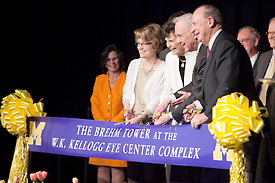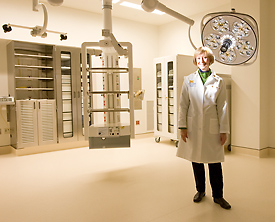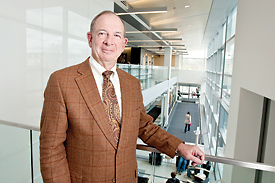It was fitting that the new Brehm Tower at the W.K. Kellogg Eye Center Complex was dedicated on a sunny late-April afternoon.
“New shoots are popping up out of the ground. This new shoot creates both clinical and research opportunities we’ve never had before,” said Dr. Peter Arvan, the Brehm Professor of Type 1 Diabetes Research, chief of the Division of Metabolism, Endocrinology & Diabetes, and director of the Comprehensive Diabetes Center.

Cutting the ceremonial ribbon for the expanded Kellogg Eye Center and new Brehm Center for Diabetes Research are, from left, President Mary Sue Coleman, donors Delores and William Brehm, and Dr. Paul Lichter, director of the Kellogg Eye Center. Looking on at left is Gail Wilensky, John M. Olin Senior Fellow at Project HOPE and one of the dedication’s featured speakers. Photo by Austin Thomason, U-M Photo Services.
On April 23 the U-M Health System (UMHS) formally dedicated the building with a “Dedicated to Discovery” ceremony. It featured tours of the building, musical performances, conferences for ophthalmologists and diabetes researchers, and a dedication event featuring university officials and leaders in the field of medicine.
Dr. Paul Lichter, chair of the Department of Ophthalmology and Visual Sciences and director of the Kellogg Eye Center, welcomed an estimated 700 friends, faculty and staff who came to celebrate a new facility designed to enhance UMHS’ capacity for eye care research and education and to unite diabetes researchers as they accelerate the search for a cure and prevention of diabetes.
Lichter observed that when university officials proposed the original W.K. Kellogg Eye Center more than 25 years ago, they cited the potential of collaboration among the Health System’s “outstanding” clinical departments and “nationally eminent” basic science departments, and especially noted the important connection between vision and diabetes research.
President Mary Sue Coleman recalled the history of the W.K. Kellogg Foundation and the generosity of its founder, Will Kellogg, who suffered from glaucoma and supported efforts to improve vision care and provide services to the blind.
“‘I would give all my money,’ he said, ‘just to see the sun and green grass again,’” Coleman said.

Carol Standardi, of Ophthalmology and Visual Sciences at the Medical School, stands in a new operating room. It features video and audio equipment to record procedures for use as a teaching tool for students. Photo by Scott Galvin, U-M Photo Services.
“It is that simple desire to see the world that drives our students, our faculty and staff, and the generous donors who support the constant quest for answers at the Kellogg Eye Center,” Coleman said. “In particular, we owe a tremendous debt of gratitude today to Bill and Dee Brehm, who have provided new momentum in our work to find a cure for type 1 diabetes and its many debilitating effects, including blindness.”
The new facility was made possible by part of a gift given to the Medical School by Delores and William Brehm in 2004.
The Brehm Tower includes 230,000 square feet, spanning eight stories, adjacent to the existing Kellogg Eye Center research tower on Wall Street in Ann Arbor. The new building houses seven eye care clinics with new suites for refractive and cosmetic surgery. The new building also serves as the main laboratory component of the Comprehensive Diabetes Center.
On the upper floors, the Brehm Center for Diabetes Research and laboratories for vision scientists will foster discoveries in both ophthalmology and diabetes. The center features an open laboratory layout to encourage collaboration, shared procedure and equipment areas, a central connecting staircase and centrally located lab services. It also houses cutting-edge facilities for communication and data sharing among diabetes researchers throughout U-M and beyond.
Dr. Ora Hirsch Pescovitz, executive vice president for medical affairs and chief executive officer of UMHS, said the unique vision of the Brehms and supporters of the eye center has opened “an important chapter in innovation and groundbreaking science.”
“We are looking to find a cure for diabetes and the broad spectrum of eye diseases that plague humanity. We will find a cure for diabetes,” she said.

Dr. Paul Lichter, director of the Kellogg Eye Center, overlooking the atrium and front entrance of the new Brehm Tower. Photo by Scott Galvin, U-M Photo Services.
Keynote speaker Gail Wilensky, John M. Olin Senior Fellow at Project Hope, said forces that made creation of the building possible — partnership and philanthropy — are typical only in the United States. “Private philanthropy is a uniquely American strategy that is needed now more than ever,” she said.
“It is the hope that this type of collective research will dominate research in the future,” she said.
Dr. Paul Sieving, director of the National Eye Institute and a former U-M ophthalmology professor, said, “This dedication marks the start of new research in diabetes and eye care.” He added that the proximity of researchers in both areas offers “a major new opportunity for both to prosper.”
The new addition fills a need to expand research programs with state-of-the-art clinics, said Douglas Strong, director and CEO of the U-M Hospitals and Health Centers. “We are not only bigger but much, much better,” he said.
A synergy will be created when diabetes and vision researchers are able to work together, said Dr. James Woolliscroft, dean of the Medical School. “I am excited about the miracles to come that will happen within these walls,” he said. “Medicine at Michigan is stronger than ever.”
Architecture firm TSA of Massachusetts created a building modern in design with features intended to evoke a warm and welcoming environment. Large windows and a full wall of glass panels on the building’s facade allow natural light to fill the clinics and common spaces, which benefits patients whose vision is impaired.
Clinics have space for patient education and comfortable waiting areas designed to aid patient flow. Research areas feature open laboratories to encourage collaboration and provide flexibility as research projects grow.

